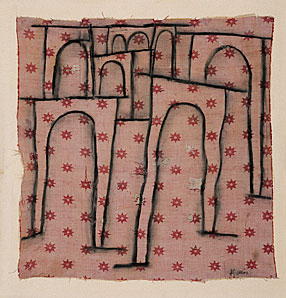 I gotta say that I was being completely sincere when I ascribed the words "great" and "meaningful" to Paul Klee's "Revolution of the Viaduct." There are only simple shapes and colors on the canvas, but is that all there is to this work? Upon closer examination, the painting reveals more than meets the eye. It seems that Klee (pronounced "clay") might have been trying to say something about individuality and non-conformity, possibly in response to the rise of the Nazi party in his homeland, Germany.
I gotta say that I was being completely sincere when I ascribed the words "great" and "meaningful" to Paul Klee's "Revolution of the Viaduct." There are only simple shapes and colors on the canvas, but is that all there is to this work? Upon closer examination, the painting reveals more than meets the eye. It seems that Klee (pronounced "clay") might have been trying to say something about individuality and non-conformity, possibly in response to the rise of the Nazi party in his homeland, Germany. Each shape resembles a cut-away section of an ancient Roman aqueduct. Each differs from the others in size, shape, color, and apparent distance from the viewer. But Klee gives us clues that he is thinking beyond mere geometry and perspective here. The serifs at the bottoms of the figures are reminiscent of feet, and transform the columns into legs. The differing lengths of the legs create the illusion that the figures are mobile, and they are coming toward us.
Each shape resembles a cut-away section of an ancient Roman aqueduct. Each differs from the others in size, shape, color, and apparent distance from the viewer. But Klee gives us clues that he is thinking beyond mere geometry and perspective here. The serifs at the bottoms of the figures are reminiscent of feet, and transform the columns into legs. The differing lengths of the legs create the illusion that the figures are mobile, and they are coming toward us. It would seem, then, that the arches are standing in for people, but why did Klee choose to paint human beings instead? His visual subject must be considered. Roman viaducts were rigid structures comprised of dozens or hundreds of columns and arches—all uniform in size and shape. Each arch yielded itself to the whole, and the structure was strong as a result. As an allegory to society, the ancient viaducts meant glorification of the whole and de-emphasized the individual. Klee seems to be suggesting something different: that society consists primarily of individuals.
It would seem, then, that the arches are standing in for people, but why did Klee choose to paint human beings instead? His visual subject must be considered. Roman viaducts were rigid structures comprised of dozens or hundreds of columns and arches—all uniform in size and shape. Each arch yielded itself to the whole, and the structure was strong as a result. As an allegory to society, the ancient viaducts meant glorification of the whole and de-emphasized the individual. Klee seems to be suggesting something different: that society consists primarily of individuals.Each figure is individual; no two are alike. Their different postures and varying degrees of motility suggest attitude and will. Klee has constructed a society that values the individual and is only loosely unified. His society derives strength from its diversity, however, and the gold, warm colors and illusion of motion suggest that it is advancing toward us, irresistibly and inevitably. Furthermore, his figures may do as they please, and while they do march toward us as a group, they will not be conformed. These seem to be the major themes of the work: individuality, non-conformity, and celebration of strength in diversity.
 Klee might also have been responding to German National Socialism (he painted the work in 1937-38). His arches defy the Nazi ideal of a homogenous super-race. The arches also stand in contrast Nazi architect Albert Speer’s uniform design of the 1936 Olympic Stadium in Berlin. Finally, the title of the painting might be a twist of Nazi propagandist Heinrich Himmler’s statement that the Bolshevics and Jews made up a “revolution of subhumans.”
Klee might also have been responding to German National Socialism (he painted the work in 1937-38). His arches defy the Nazi ideal of a homogenous super-race. The arches also stand in contrast Nazi architect Albert Speer’s uniform design of the 1936 Olympic Stadium in Berlin. Finally, the title of the painting might be a twist of Nazi propagandist Heinrich Himmler’s statement that the Bolshevics and Jews made up a “revolution of subhumans.”Klee once said his goal was to paint the human spirit. In “Revolution,” he has done it as a celebration of individuality and a rejection of all that would quash it.
2 comments:
I'm going to check more into his work. This is why the arts are so important. Did he get into any trouble for his work(s)?
The Nazis dismissed Klee from his professorship at the Dusseldorf Academy in 1931. He fled to Switzerland in 1937. The Nazis seized many of his paintings and even displayed seventeen of them in an exhibit of "degenerate art."
Post a Comment